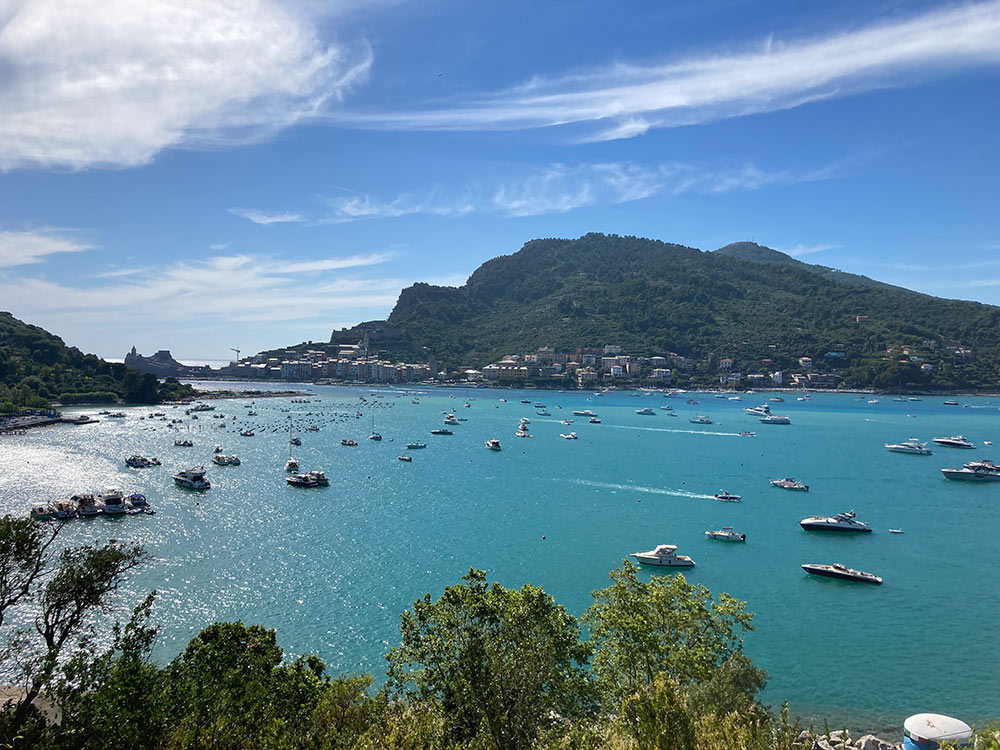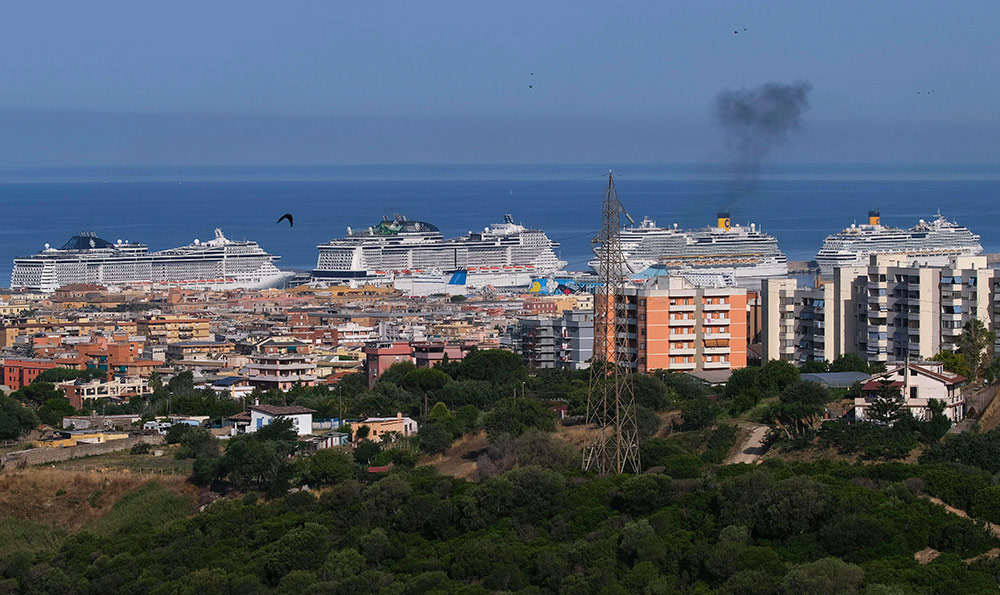太煞风景了!“幽灵”游轮停靠意大利里维埃拉

一些意大利人说,如果从港口城市拉斯佩齐亚的山顶俯瞰利古里亚的诗人湾的全景,你就可以饱览这个国家举世闻名的美景。几个世纪以来,这些美景的确吸引了一些世界上最伟大的艺术家。
在你的右手边,面朝西,屹立在岩石半岛的顶端是尖塔耸立的哥特式圣彼得教堂。继续往前探索,几个人烟稀少的岛屿映入眼帘。在你的左边是一排朝东的码头和一幢桃红色的建筑,它们在绵延起伏的绿色山丘的映衬下显得格外小巧。
这片美景震撼了拜伦——在韦内雷港(联合国教科文组织世界遗产)有一个半淹没式的洞穴以他的名字命名——同时查尔斯·狄更斯、珀西和玛丽·雪莱、D·H·劳伦斯和弗吉尼亚·伍尔夫等人也在此处流连忘返。

然而,在过去的一年半里,有一片新的“风景”出现在人们的视野里:三艘巨大的歌诗达邮轮(Costa Cruises)停靠在海湾中心,发动机在不停运转,灯也亮着,船上还有一小队船员。当新冠疫情使从东京到迈阿密的游轮行业陷入困境时,“幽灵船”受到了沉重的打击。而且它们并不受当地人欢迎。
“它们很煞风景。”塔尼亚·卡伦达告诉《财富》杂志,她是拉斯皮齐亚的艺术策展人,经营着文化机构Sixteen Art & More。“我们美丽的海岸线风景被这些巨大的船只破坏了。在过去一年半的时间里,它们一直在我们的视野里。每个人都受够了它们的存在。”
“毫无用处的船只”
对游轮运营商来说,过去的18个月令人难忘。
意大利和世界大部分地区的旅游业因为新冠疫情而受到的影响微乎其微。但邮轮行业受到的影响过大,原因是在邮轮狭窄的空间里容易引发疫情,经常与同一个人接触并且很难隔离潜在的感染者。总而言之,投资者在过去两年中一直在抛售游轮类股票。
最重要的是,意大利标志性的运河城市威尼斯——世界顶级游轮目的地之一——今年夏天禁止大型船只进入其港口,原因是担心船只影环境响和破坏城市薄弱的基础设施。
“旅游业受到了巨大影响。”佛罗伦萨旅游研究中心(Center for Touristic Studies in Florence)的研究主管詹弗兰科·洛伦佐说,“该行业需要数年时间才能够恢复到以前的水平。”
根据洛伦佐的说法,在正常情况下,每年游轮在意大利接待1300万游客。媒体报道称,尽管今年公司谨慎地重新启用游轮,但只有大约五分之一的商业游轮在使用,而那些正在使用的游轮的运力远远低于容量。
Fincantieri Foundation(意大利芬坎蒂尼欧洲最大的造船商)的海军历史学家马泰奥·马丁努齐告诉《财富》杂志,游轮运营商唯一遭受类似影响的时期是在两次世界大战期间,当时用于跨大西洋和地中海客运的船只,不属于游船性质,而是作为军事用船。
马丁努齐说:“当然,最大的不同是,在战争期间,这些船仍然在使用。现在,在大多数情况下,它们已经没有什么作用可以发挥了。”
遍及整个意大利
毫无用处的船只远不止在诗人湾停靠。
意大利环保游说团体Legambiente估计,大约有100艘大型游轮停泊在意大利港口或附近地区。据意大利媒体报道,其中地中海邮轮(MSC Cruise)停靠在罗马主要港口奇维塔韦基亚附近,还有亚得里亚海港口城市里雅斯特、巴勒莫和锡拉丘兹的西西里港口,以及威尼斯。据报道,在诗人湾抛锚的三艘船的所有者歌诗达游轮公司还在热那亚、奇维塔韦基亚和那不勒斯附近停靠了其他船只。报道还称,小型游轮公司的船只停靠在布林迪西、卡塔尼亚和利沃诺等旅游目的地附近。
歌诗达邮轮公司没有回应《财富》杂志的置评请求,地中海邮轮公司的一位发言人拒绝讨论这个话题。

据当地新闻报道,这些船只停泊在港口附近的主要为了保持良好的工作状态,以便能够迅速为服务做好准备,并为重要船员提供港口服务。
环境保护组织Legambiente Liguria的副总裁斯特凡诺·萨尔蒂表示,这种策略是目光短浅的。他说,停靠的船只不仅破坏了风景,还会对环境造成危害,而且24小时不停地发出噪音。
在夏季的早些时候,他的观点就得到众人的支持。到了晚上,游轮的运营者打开灯,把船照得像诗人湾中的圣诞树一样闪闪发亮。白天,船长打开巨大的引擎,这艘巨大的船就会故意在水中缓慢地转个圈。偶尔,船员会对着巨型雕像沮丧地鸣笛,岸上的人会对这种十分奇怪的日常操作十分反感。
萨尔蒂说,Legambiente组织正在考虑发布一份请愿书,要求意大利政府禁止游轮公司在该国最美丽的景点附近停泊船只。
萨尔蒂对《财富》杂志说:“我知道船舶必须停靠在某个地方,但我们必须在船舶运营商的需求和该国的环境保护方面之间取得平衡。解决方案决不可能是把风景优美的港口变成大型游轮的停车场。”(财富中文网)
编译:於欣
一些意大利人说,如果从港口城市拉斯佩齐亚的山顶俯瞰利古里亚的诗人湾的全景,你就可以饱览这个国家举世闻名的美景。几个世纪以来,这些美景的确吸引了一些世界上最伟大的艺术家。
在你的右手边,面朝西,屹立在岩石半岛的顶端是尖塔耸立的哥特式圣彼得教堂。继续往前探索,几个人烟稀少的岛屿映入眼帘。在你的左边是一排朝东的码头和一幢桃红色的建筑,它们在绵延起伏的绿色山丘的映衬下显得格外小巧。
这片美景震撼了拜伦——在韦内雷港(联合国教科文组织世界遗产)有一个半淹没式的洞穴以他的名字命名——同时查尔斯·狄更斯、珀西和玛丽·雪莱、D·H·劳伦斯和弗吉尼亚·伍尔夫等人也在此处流连忘返。
然而,在过去的一年半里,有一片新的“风景”出现在人们的视野里:三艘巨大的歌诗达邮轮(Costa Cruises)停靠在海湾中心,发动机在不停运转,灯也亮着,船上还有一小队船员。当新冠疫情使从东京到迈阿密的游轮行业陷入困境时,“幽灵船”受到了沉重的打击。而且它们并不受当地人欢迎。
“它们很煞风景。”塔尼亚·卡伦达告诉《财富》杂志,她是拉斯皮齐亚的艺术策展人,经营着文化机构Sixteen Art & More。“我们美丽的海岸线风景被这些巨大的船只破坏了。在过去一年半的时间里,它们一直在我们的视野里。每个人都受够了它们的存在。”
“毫无用处的船只”
对游轮运营商来说,过去的18个月令人难忘。
意大利和世界大部分地区的旅游业因为新冠疫情而受到的影响微乎其微。但邮轮行业受到的影响过大,原因是在邮轮狭窄的空间里容易引发疫情,经常与同一个人接触并且很难隔离潜在的感染者。总而言之,投资者在过去两年中一直在抛售游轮类股票。
最重要的是,意大利标志性的运河城市威尼斯——世界顶级游轮目的地之一——今年夏天禁止大型船只进入其港口,原因是担心船只影环境响和破坏城市薄弱的基础设施。
“旅游业受到了巨大影响。”佛罗伦萨旅游研究中心(Center for Touristic Studies in Florence)的研究主管詹弗兰科·洛伦佐说,“该行业需要数年时间才能够恢复到以前的水平。”
根据洛伦佐的说法,在正常情况下,每年游轮在意大利接待1300万游客。媒体报道称,尽管今年公司谨慎地重新启用游轮,但只有大约五分之一的商业游轮在使用,而那些正在使用的游轮的运力远远低于容量。
Fincantieri Foundation(意大利芬坎蒂尼欧洲最大的造船商)的海军历史学家马泰奥·马丁努齐告诉《财富》杂志,游轮运营商唯一遭受类似影响的时期是在两次世界大战期间,当时用于跨大西洋和地中海客运的船只,不属于游船性质,而是作为军事用船。
马丁努齐说:“当然,最大的不同是,在战争期间,这些船仍然在使用。现在,在大多数情况下,它们已经没有什么作用可以发挥了。”
遍及整个意大利
毫无用处的船只远不止在诗人湾停靠。
意大利环保游说团体Legambiente估计,大约有100艘大型游轮停泊在意大利港口或附近地区。据意大利媒体报道,其中地中海邮轮(MSC Cruise)停靠在罗马主要港口奇维塔韦基亚附近,还有亚得里亚海港口城市里雅斯特、巴勒莫和锡拉丘兹的西西里港口,以及威尼斯。据报道,在诗人湾抛锚的三艘船的所有者歌诗达游轮公司还在热那亚、奇维塔韦基亚和那不勒斯附近停靠了其他船只。报道还称,小型游轮公司的船只停靠在布林迪西、卡塔尼亚和利沃诺等旅游目的地附近。
歌诗达邮轮公司没有回应《财富》杂志的置评请求,地中海邮轮公司的一位发言人拒绝讨论这个话题。
据当地新闻报道,这些船只停泊在港口附近的主要为了保持良好的工作状态,以便能够迅速为服务做好准备,并为重要船员提供港口服务。
环境保护组织Legambiente Liguria的副总裁斯特凡诺·萨尔蒂表示,这种策略是目光短浅的。他说,停靠的船只不仅破坏了风景,还会对环境造成危害,而且24小时不停地发出噪音。
在夏季的早些时候,他的观点就得到众人的支持。到了晚上,游轮的运营者打开灯,把船照得像诗人湾中的圣诞树一样闪闪发亮。白天,船长打开巨大的引擎,这艘巨大的船就会故意在水中缓慢地转个圈。偶尔,船员会对着巨型雕像沮丧地鸣笛,岸上的人会对这种十分奇怪的日常操作十分反感。
萨尔蒂说,Legambiente组织正在考虑发布一份请愿书,要求意大利政府禁止游轮公司在该国最美丽的景点附近停泊船只。
萨尔蒂对《财富》杂志说:“我知道船舶必须停靠在某个地方,但我们必须在船舶运营商的需求和该国的环境保护方面之间取得平衡。解决方案决不可能是把风景优美的港口变成大型游轮的停车场。”(财富中文网)
编译:於欣
There are some in Italy who say the panorama of Liguria’s Gulf of Poets from atop the hills of the port city of La Spezia might just be the most beautiful spot in a country renowned for breathtaking views. It's certainly stirred some of the world's greatest artists over the centuries.
To the right, facing west, the rocky peninsula is accented at its tip by the sharp-cornered, Gothic Church of St. Peter. Beyond, a few uninhabited islands come into view. To the left, facing east, an array of docks and a peach-colored buildings are dwarfed by the green rolling hills rising up behind them.
This panorama inspired Lord Byron—who has a half-submerged cave named for him in Porto Venere (a UNESCO World Heritage site)—as well as the likes of Charles Dickens, Percy and Mary Shelley, D.H. Lawrence, and Virginia Woolf.
For the last year and a half, though, there’s been a new addition dominating the view: three massive Costa Cruises ships are parked pluck in the center of the gulf, motors running, lights on, and with small crews aboard. The ghost vessels are victims of the dramatic blow that struck the cruise ship industry when the coronavirus pandemic marooned the sector from Tokyo to Miami. And they are not popular with locals.
“They’re an eyesore,” Tania Calenda, a La Spezia-based art curator who runs the culture organization Sixteen Art & More, told Fortune. “We have such a beautiful coastline marred by these massive ships. They’ve been part of our view now for a year and a half. Everyone's tired of having them there.”
“No useful role”
The last 18 months have been ones to forget for cruise ship operators.
The pandemic reduced tourism in Italy, and most of the world, to a trickle. But cruise lines suffered over-sized impacts because of pandemic-related risks connected to cruise ships’ confined spaces, frequent exposure to the same people, and the difficulty of isolating potentially infected individuals. Add it all up, and investors have pounded cruise ship stocks over the past two years.
Then, to top things off, the iconic Italian canal city of Venice—one of the world’s top cruise ship destinations—banned the largest ships from entering its harbor this summer due to worries over environmental impacts and damage to the city’s fragile infrastructure.
“The harm the industry has enormous,” said Gianfranco Lorenzo, head of research at the Center for Touristic Studies in Florence. “It’s going to take years for the sector to recover to previous levels.”
In a normal year, according to Lorenzo, cruise ships would serve 13 million tourists annually in Italy. Media reports say that despite a cautious relaunch this year, only around one in five commercial cruise ships is being used, and those that are in use are operating far below capacity.
Matteo Martinuzzi, a naval historian with the Fincantieri Foundation (Italy-based Fincantieri Europe’s largest shipbuilder), told Fortune that the only period where passenger ship operators suffered similar impacts was during the two World Wars, when ships—then used for trans-Atlantic and Mediterranean passenger transport, not pleasure cruises—were commandeered for military use.
“The big difference, of course, is that during the wars the ships were still being used,” Martinuzzi said. “Now, for the most part, they have no useful role to play.”
All over Italy
The practice of parking out-of-use ships goes far beyond the Gulf of Poets.
Legambiente, an Italian environmental lobby group, estimates that around 100 large cruise ships are parked in or near Italian ports. According to Italian media reports, they include MSC Cruise ships near Civitavecchia, Rome’s main port, the Adriatic port city of Trieste, the Sicilian ports of Palermo and Syracuse, and Venice. Costa, owner of the three ships anchored off the Gulf of Poets, reportedly has other ships parked outside nearby Genoa, at Civitavecchia, and Naples. Ships from smaller cruise companies have reportedly been spotted parked near tourist destinations including Brindisi, Catania, and Livorno.
Costa Cruises did not respond to Fortune’s requests for comment, and a spokesman for MSC Cruises declined to discuss the topic.
According to local news reports, the main reason the ships are parked near ports is to keep them in good working order so they can be quickly made ready for service, and to give the skeleton crews access to port services.
Stefano Sarti, vice president of Legambiente Liguria, says the strategy is short-sighted. In addition to marring picturesque views, he asserts the parked ships cause environmental harm and make noise around the clock.
His complaint was on full view earlier in the summer season. At night, the cruise ship operators flip on the lights, illuminating the vessels like Christmas trees in the middle of the Gulf of Poets. During the day, a captain turns on the massive engines and the enormous ship would make a deliberately slow-go circle in the waters. The occasional boater would deliver a frustrated honk at the colossus, and those on shore would shake their head at the hardly subtle routine maneuver.
Sarti said Legambiente is considering a petition to ask the Italian government to prohibit cruise ship companies from parking their vessels near the country’s most scenic and vulnerable spots.
“I understand that the ships have to be anchored somewhere, but there must be a balance between the needs of the ship operators and the environmental health of some delicate parts of the country,” Sarti told Fortune. “The answer can’t be to turn scenic ports into parking lots for grotesquely large cruise ships.”













